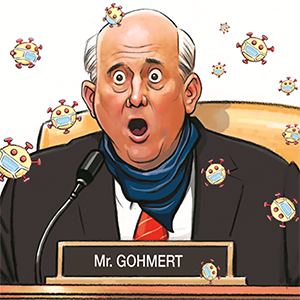Politics
/ArcaMax

Commentary: Big law must stop caving to Trump's demands
Big law firms that have offended President Donald Trump for representing a cause or client he doesn’t like are being forced to make a choice: Either cut a deal with him to protect their billion-dollar businesses, or sue him to assert their right to continue representing clients as they please.
It was extremely disappointing when Paul, Weiss, ...Read more

Commentary: President Donald Trump's tariffs will cost us
As President Donald Trump laid out his case for sweeping new tariffs, it sounded reasonable. He was only imposing on other countries the burden they impose on us. Those tariffs, he said, would boost our national revenue and decrease our deficit. He recalled a wealthy America 150 years ago funded entirely by tariffs instead of a pesky income tax,...Read more

Hal Brands: Trump's threats and tariffs are a global 'kill switch'
Sometimes, a small incident reveals larger truths about our world. Consider reports that some North Atlantic Treaty Organization allies are rethinking plans to buy American-made F-35 fighters. This story isn’t just about a plane: It is a window into the remarkable power imbalances and dependencies at the heart of the modern international ...Read more

Editorial: America just dumped the world. New loves will be forthcoming
As antacid-chugging Americans watched their portfolios and retirement account balances drop Thursday, it was easy to forget another consequence of Donald Trump’s ill-considered splaying the day before of new U.S. tariffs on nations large, small and uninhabited.
The likelihood of this nation losing its role as a global leader, leadership being...Read more

Conor Sen: Where will consumers go?
Investors crushed the stocks of consumer discretionary companies on Thursday in response to President Donald Trump’s tariff announcement, making little distinction between home goods companies such as Williams-Sonoma Inc., apparel names including Nike Inc. or restaurants such as Cheesecake Factory Inc. The concern about consumers makes sense; ...Read more

Commentary: Of course Sundance is fleeing. Utah has become a hateful place
This past week, the Sundance Film Festival announced it will soon leave its four-decade-plus home in Park City, Utah, for Boulder, Colorado. The gut reaction from many was “Why did they leave?” Some close watchers answered by focusing on the “political” angle to explain the hop over the state line — that it was all about “leaving the...Read more

Editorial: Indiscriminate tariffs threaten rest of Trump's agenda
Not yet three months into a second term, President Donald Trump has taken difficult, but necessary, actions to rein in the scope of a federal government on a fiscally unsustainable path. He is also working with Republicans in Congress to extend his 2017 tax cut bill, allowing Americans to keep more of their own money. These are positive steps.
...Read more

David M. Drucker: Woke baggage weighs down Democrats' economic message
As Democrats attempt to unite around a new economic populism, Republicans can hardly believe their luck. Five months after President Donald Trump defeated then-Vice President Kamala Harris to win a White House encore, Democrats are still refusing to jettison the politically damaging progressive dogma on cultural issues — blunting any advantage...Read more

Commentary: Make polluters pay for climate impacts
The first two months of Donald Trump’s second presidency have been marked by a whirlwind of dangerous climate-related executive orders and frightening, fossil fuel industry-friendly cabinet confirmations.
Every day makes more clear what climate advocates have been warning us about: Trump is actively and deliberately destroying any hope of ...Read more

Lisa Jarvis: This isn't how you make America healthy again
Robert F. Kennedy Jr.’s grand plan for Making America Healthy Again is taking shape. It centers on dismantling the public health systems that have kept Americans safe for decades.
The damage from sweeping cuts this week at the Department of Health and Human Services, which Kennedy oversees, will be felt within public health, the biomedical ...Read more

Commentary: Are federal spending laws subject to private lawsuits? SCOTUS to decide
Any Supreme Court case involving Planned Parenthood is likely to attract attention, and Medina v. Planned Parenthood, argued on April 2, is no exception.
But this case’s implications go far beyond Planned Parenthood. The court’s decision could open the door even wider for lawsuits against any number of federal spending programs.
In this ...Read more

Commentary: The evolving social contract -- From common good to contemporary practice
The concept of the common good in American society has undergone a remarkable transformation since the nation's founding. What began as a clear, if contested, vision of collective welfare has splintered into something far more complex and individualistic. This shift reflects changing times and a fundamental reimagining of what we owe each other ...Read more

Commentary: It's time to defend the guardrails of democracy
Lawyers know that President Donald Trump’s executive orders targeting individual law firms, and now, the entire legal profession, are illegal and unconstitutional.
The situation puts a choice to every lawyer and every law firm. Do you fight – speak out and act out against this lawless behavior? Or do you accommodate it, keep your head down...Read more

Commentary: Political fear stalks law, education, journalism, migration
Something new has entered American consciousness: fear of the state.
Not since the Red Scares (the first one followed the Russian Revolution and World War I, and the second followed World War II and the outbreak of the Cold War) has the state taken such an active role in political intervention.
The state under Donald Trump has a special ...Read more

Editorial: Don't make Luigi Mangione a martyr
The death penalty should be off the table for Luigi Mangione, accused killer of UnitedHealthcare CEO Brian Thompson. And not for any reason sympathetic to Mangione.
Attaching the death penalty to Mangione’s trial would only make a martyr out of an accused killer who has already inspired zealous support among legions of fans.
Ever since ...Read more

Commentary: America is headed for a grim fiscal reckoning
Amid all the blaring headlines coming out of Washington, here’s a piece of news that is getting far too little attention: The U.S. is on course for fiscal breakdown.
That’s the unambiguous message from the Congressional Budget Office’s newly updated long-term projections. Unless Congress changes course, there’ll be a reckoning, and it ...Read more

David Mastio: No, Mr. Trump, Canada is not an 'emergency,' nor are the others you have authorized
We all know an emergency when we see one — in our personal lives, it can be a car accident or a sudden illness. Emergencies happen to nations as well: Earthquakes and hurricanes, invasions and pandemics — they’re easy to recognize.
If you’re president, though, all bets are off. Congress gave presidents power to act in emergencies and ...Read more

Editorial: Trump's foolish tariffs take the US economy back centuries
One thing you can say in favor of President Donald Trump’s announcement Wednesday from the Rose Garden: He did what he promised during the campaign.
For months as stock markets gyrated on news and rumors of Trump’s tariff plans, with the president making protectionist pronouncements and then backtracking in the face of resistance from ...Read more

Michael Hiltzik: GOP thinks the court orders they used against Biden should be outlawed -- because they now target Trump
The old political adage that "where you stand depends upon where you sit" has been getting aired out in Washington.
Republicans and conservatives used to celebrate judges' issuance of nationwide court injunctions to block Biden policies or progressive government programs.
Now that nationwide court injunctions are being used to block Trump ...Read more

Commentary: Financial illiteracy is symptomatic of larger problems in America
Linda McMahon, the new secretary of education, has her hands full. Her game plan is to dissolve the Department of Education. Given her business background, she would be wise to look at the state of financial literacy in the population as the “canary in the mine shaft” for not shuttering the department, but remaking K-12 education.
The ...Read more


























































